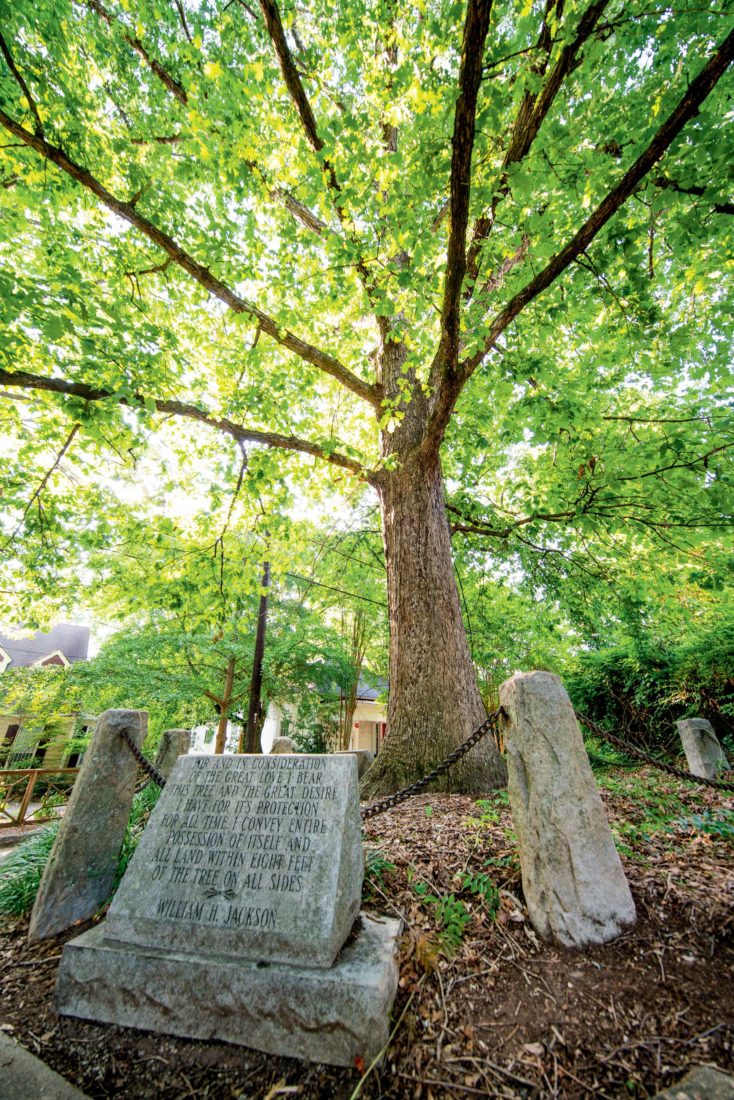Pilgrims travel to the Dearing Street Historic District of Athens, Georgia, in sedans, minivans, and limousines. They visit briefly and leave flowers, or they stay for hours and take selfies. And every year around graduation, students departing the University of Georgia campus show up to say goodbye to one of the city’s most beloved residents.
Each traveler must navigate around a tree growing in the middle of the road. In some communities, people might view this as a hindrance. But in Athens, the white oak slowing down traffic isn’t an obstacle; it’s the celebrity folks are seeking.
Known as the Tree That Owns Itself, the oak has grand limbs that seem to stretch from one side of the road to the other. A stone tablet at its base briefly explains that a man named William H. Jackson deeded the tree—and eight feet of land on all sides of it—to itself. When one of the tree’s closest neighbors, Ashley Simpson, spends time in her yard, visitors often wander over to ask questions. “The thing most people want to know,” she says, “is how could a tree own itself?”
As the story goes, Jackson loved the tree so dearly that, more than a century ago, he bequeathed it property rights so that it might control its own destiny. But no one can locate the actual deed. The newspaper article that first publicized his statement, in 1890, was submitted anonymously. Was the story historical farce? A mock challenge for law students? No one knows. Nevertheless, the concept of legal personhood has saved the Tree That Owns Itself time and again, even in the face of disaster.
In 1942, high winds toppled the original oak, believed to have been as old as four hundred years. Four years later, arboreally minded citizens planted a sapling grown from one of its acorns, to great fanfare. The act has inspired countless modern-day residents, including Simpson, to nurture acorns in planters, just in case another heir is needed.
The tree’s story of owning itself has, ironically, led generations of Athens locals to take greater ownership of it. Simpson recently moved fourteen wheelbarrows of its fallen branches and leaves out of the street. But like many of the tree’s other neighbors—some of whom like to joke that it’s the Tree That Doesn’t Pick Up After Itself—she has developed an abiding love for it. “I see myself as just a dot in between the past and the future,” she says. “Somebody took care of the Tree That Owns Itself before I was here, and I’m hopeful there are people who will help take care of it after I’m gone. Living with the Tree That Owns Itself gives me a sense of continuity.”
Human development often dictates where trees exist. They are bulldozed to make way or planted as landscaping afterthoughts. But the Tree That Owns Itself remains an anchor that builders and road crews have worked around for generations, a precursor of sorts to the global Rights of Nature movement, which seeks legal standing for natural features including trees and rivers. And it’s as much a part of local culture as the Grit restaurant or R.E.M.
Today, Athens protects its canopy as a Tree City USA. It has its own tree council and an appointed community forester, Rodney Walters. As Athens–Clarke County’s resident tree expert, he is, in a sense, the official human representative for the Tree That Owns Itself, since the oak occupies a municipal right-of-way.
“Humans attempt to a large degree to exist outside of nature,” Walters says. “But the study of ecology has a message that we are not separate from our environment.” Trees, like people, were also not meant to live on their own. “If a tree is surrounded by forest and it is left as a single tree standing, it is suddenly exposed,” he says. “The wind around it changes. The hydrology that supports it changes. But trees, even isolated, are adaptive. They’re resilient. The Tree That Owns Itself’s survival is an example of what’s possible in the cohabitation of trees and people.”
If the oak were still part of a forest—if its brethren had not fallen for land and lumber—its closest human neighbors wouldn’t need to gather wheelbarrows of its brush, because that debris would be feeding a forest floor. The Junior Ladies Garden Club would be saved the trouble of laying mulch at the base of its trunk to prevent erosion. Contractors from New Urban Forestry would not have installed protective lightning rods, required since the tree is no longer surrounded by other towering creatures. Alone, the tree is vulnerable. But given all the human hands that labor on its behalf, and the visitors who come to pay their respects, this famously singular, self-determined oak isn’t actually living solo. “The Tree That Owns Itself depends on humans to be its forest,” Walters says. “It gives people permission to care.”








